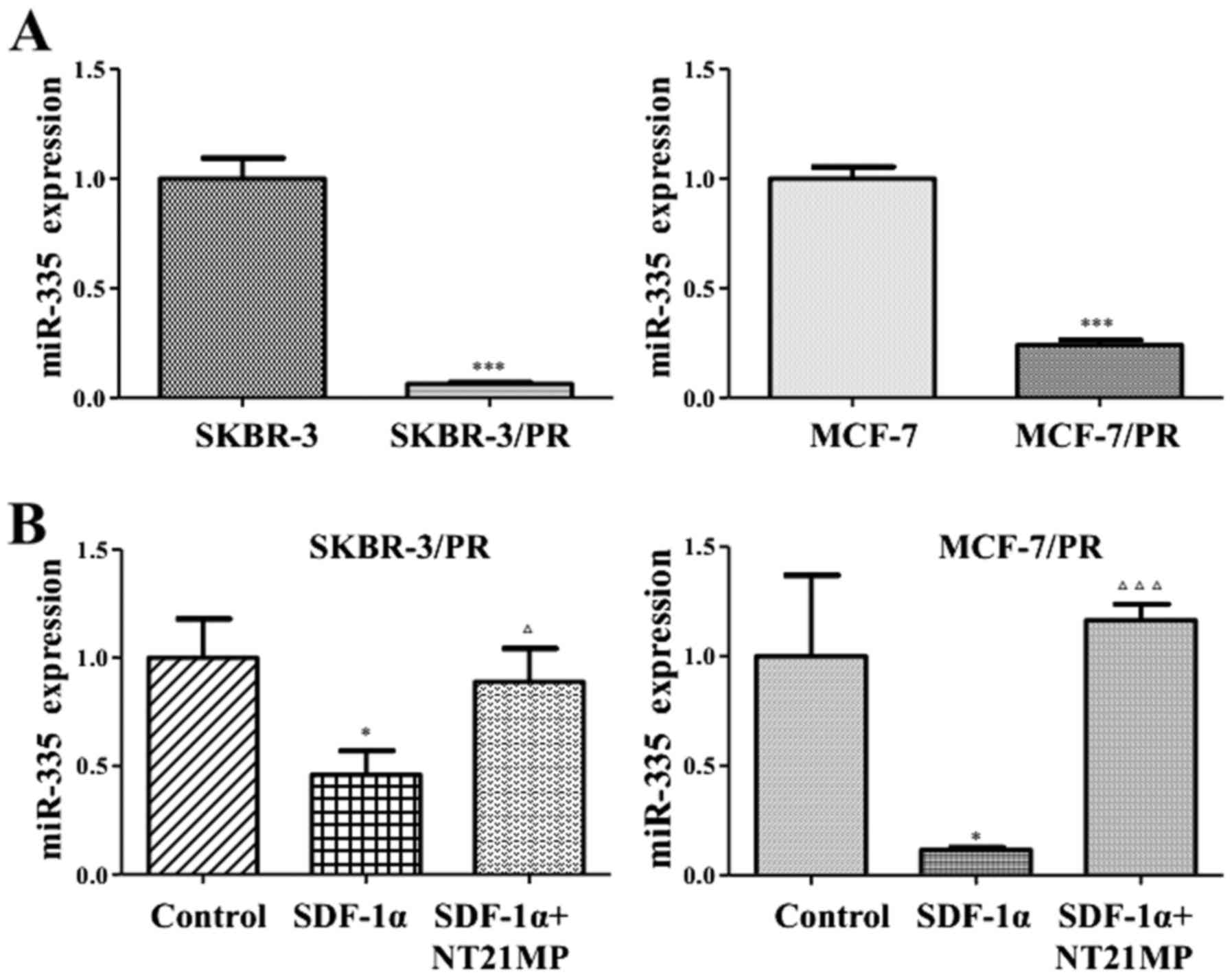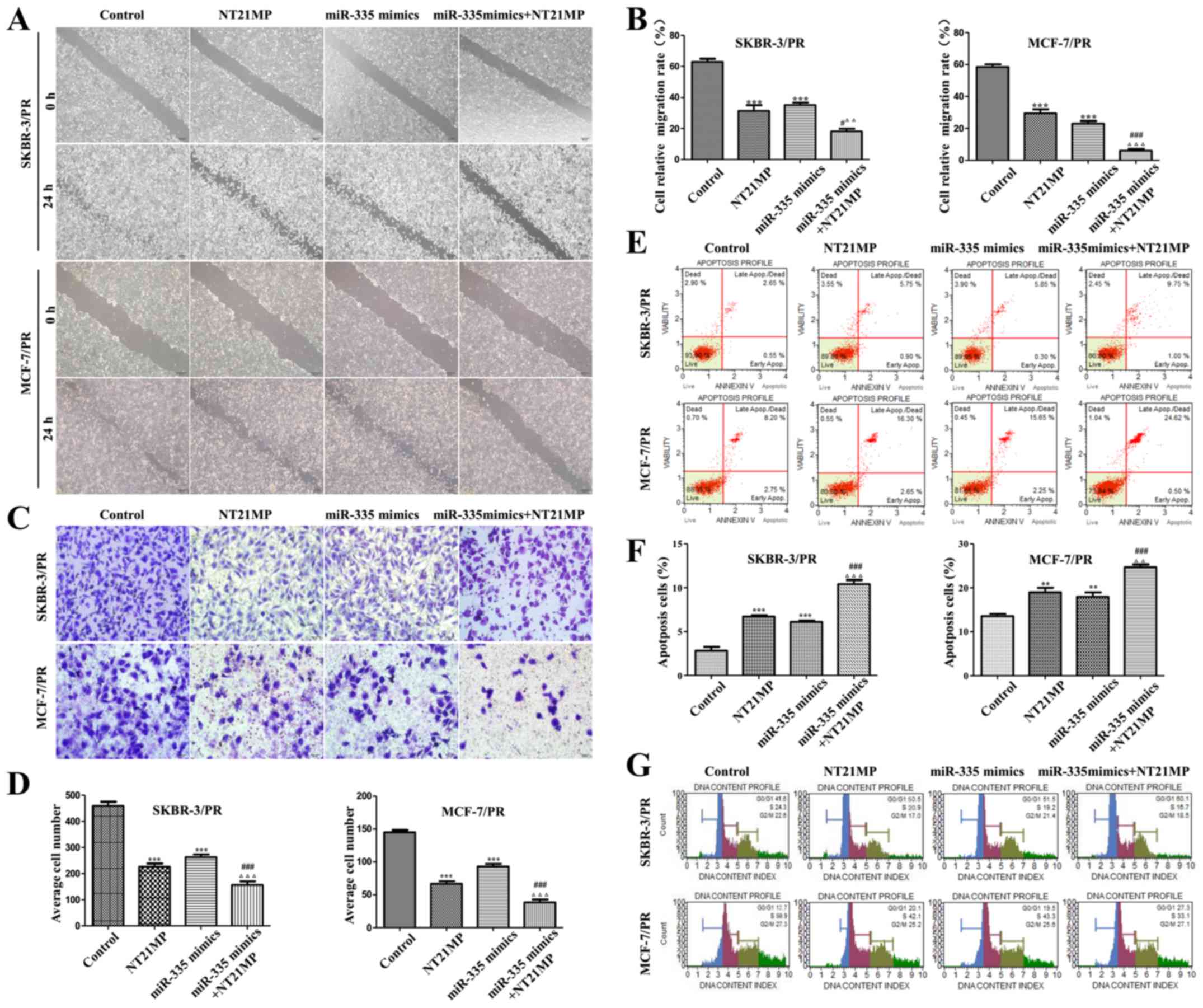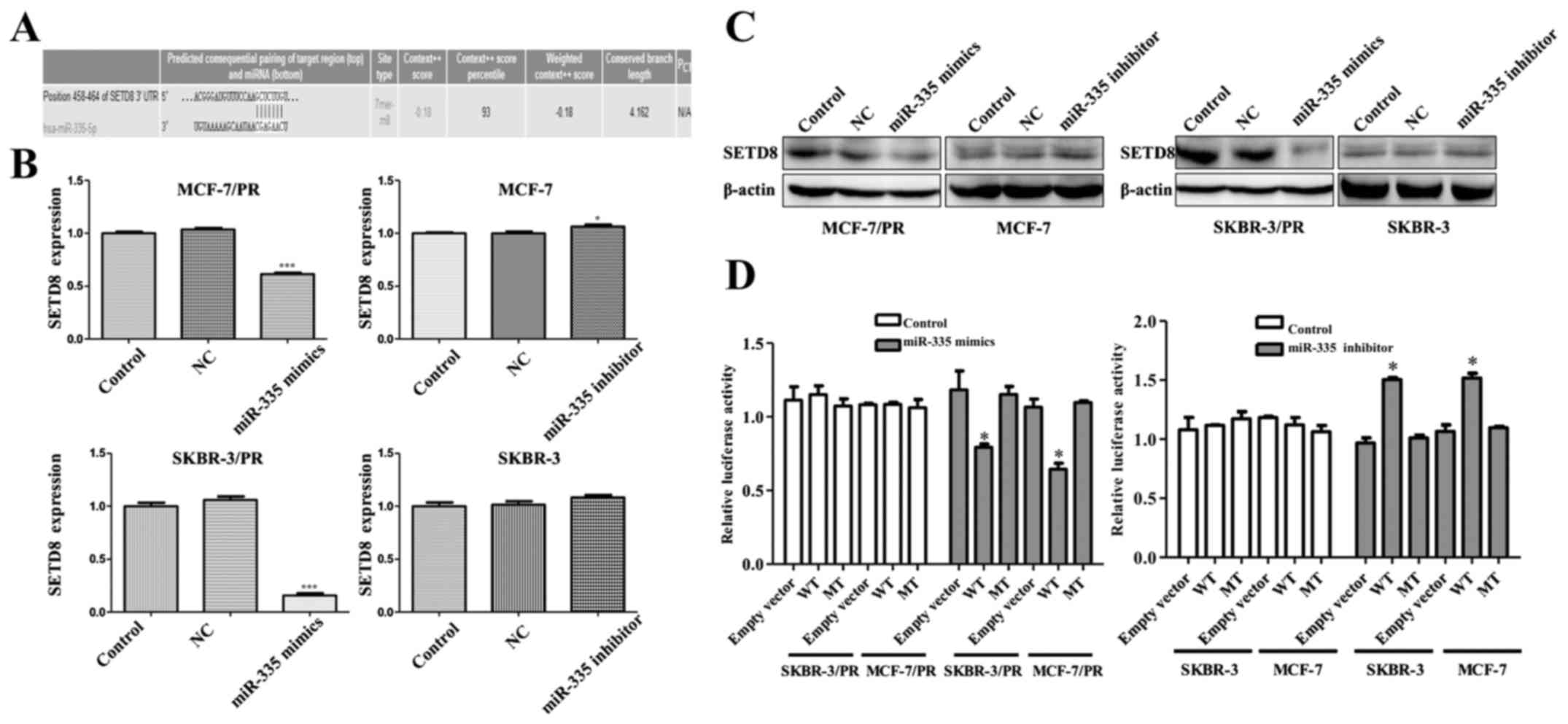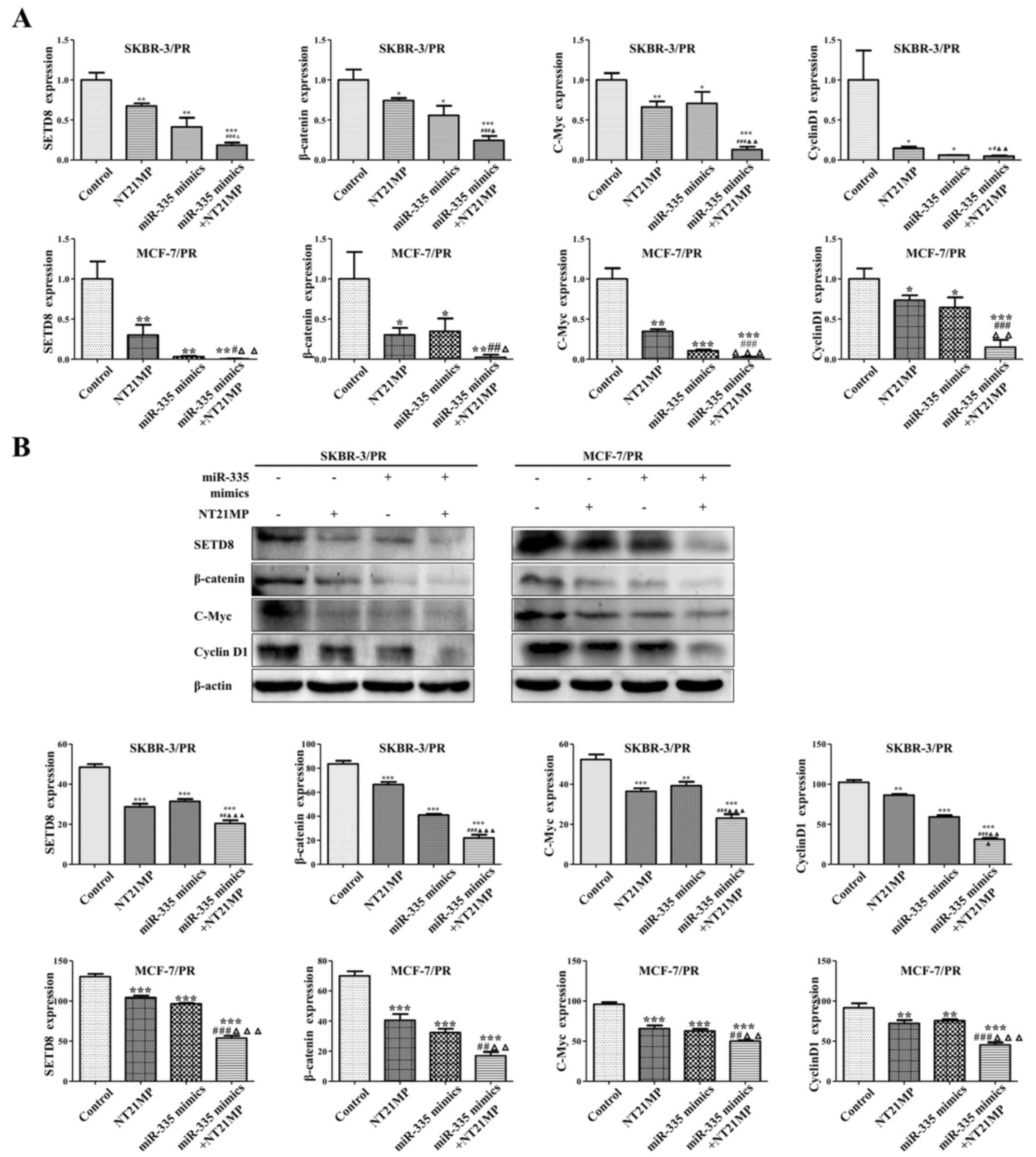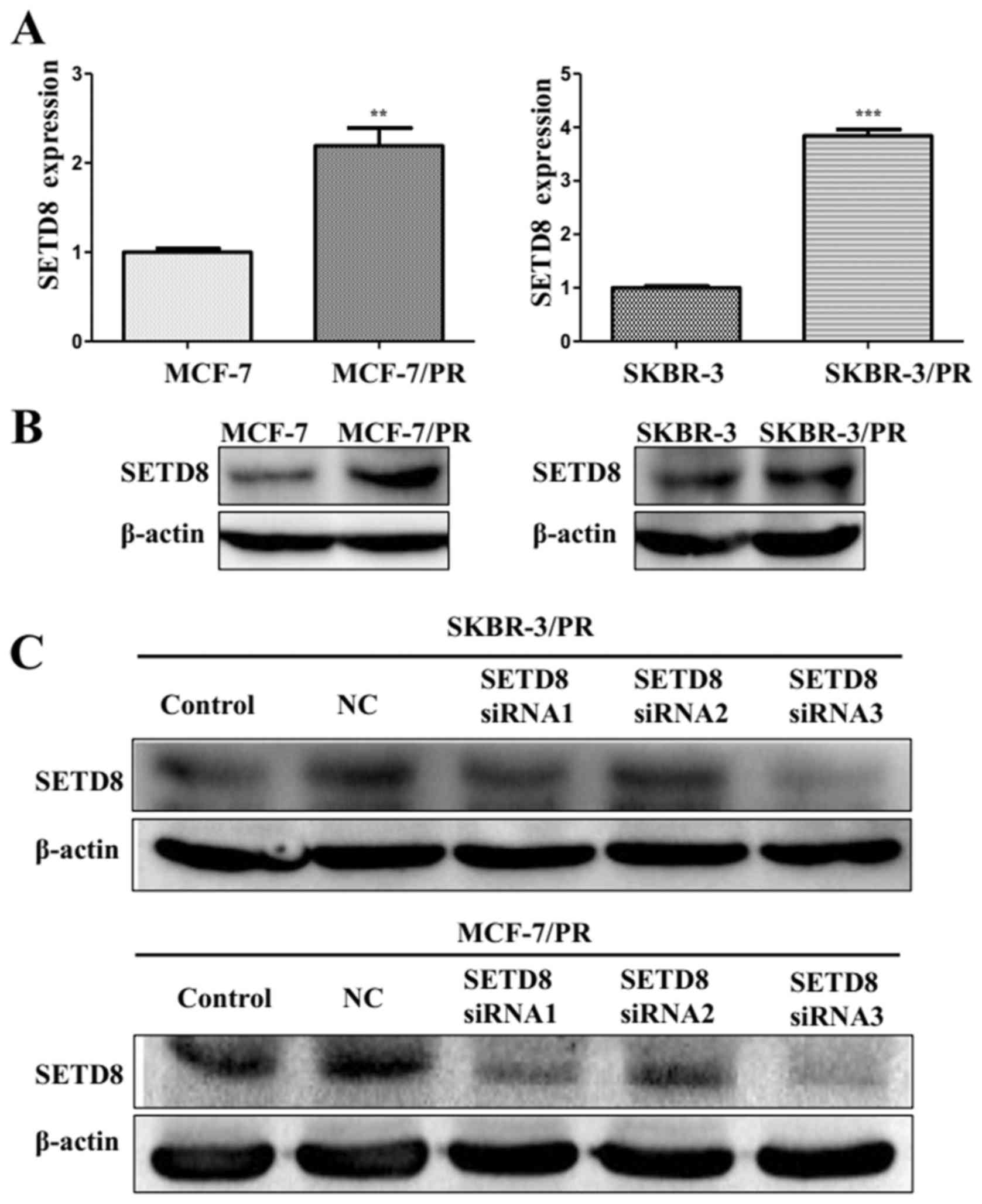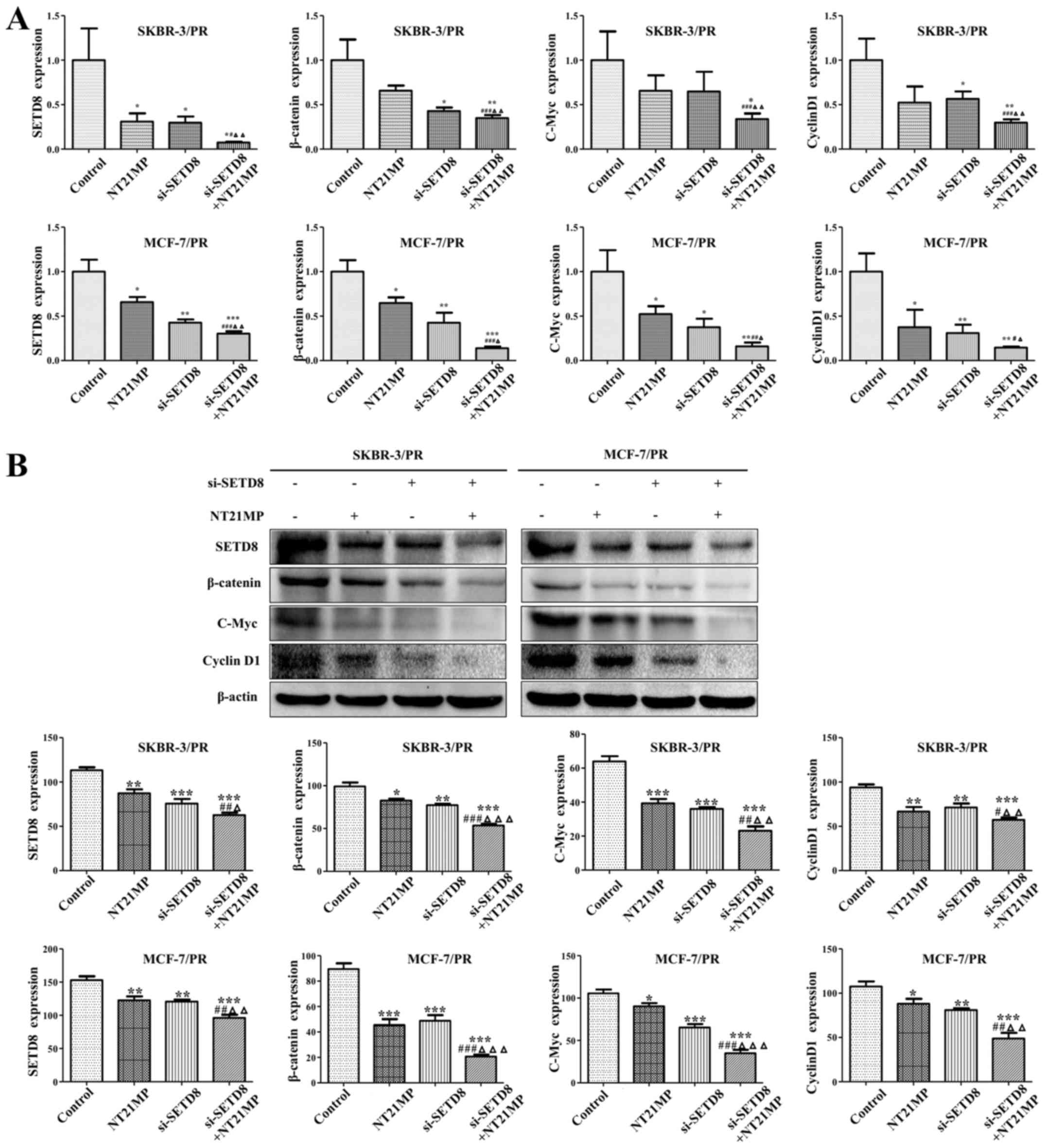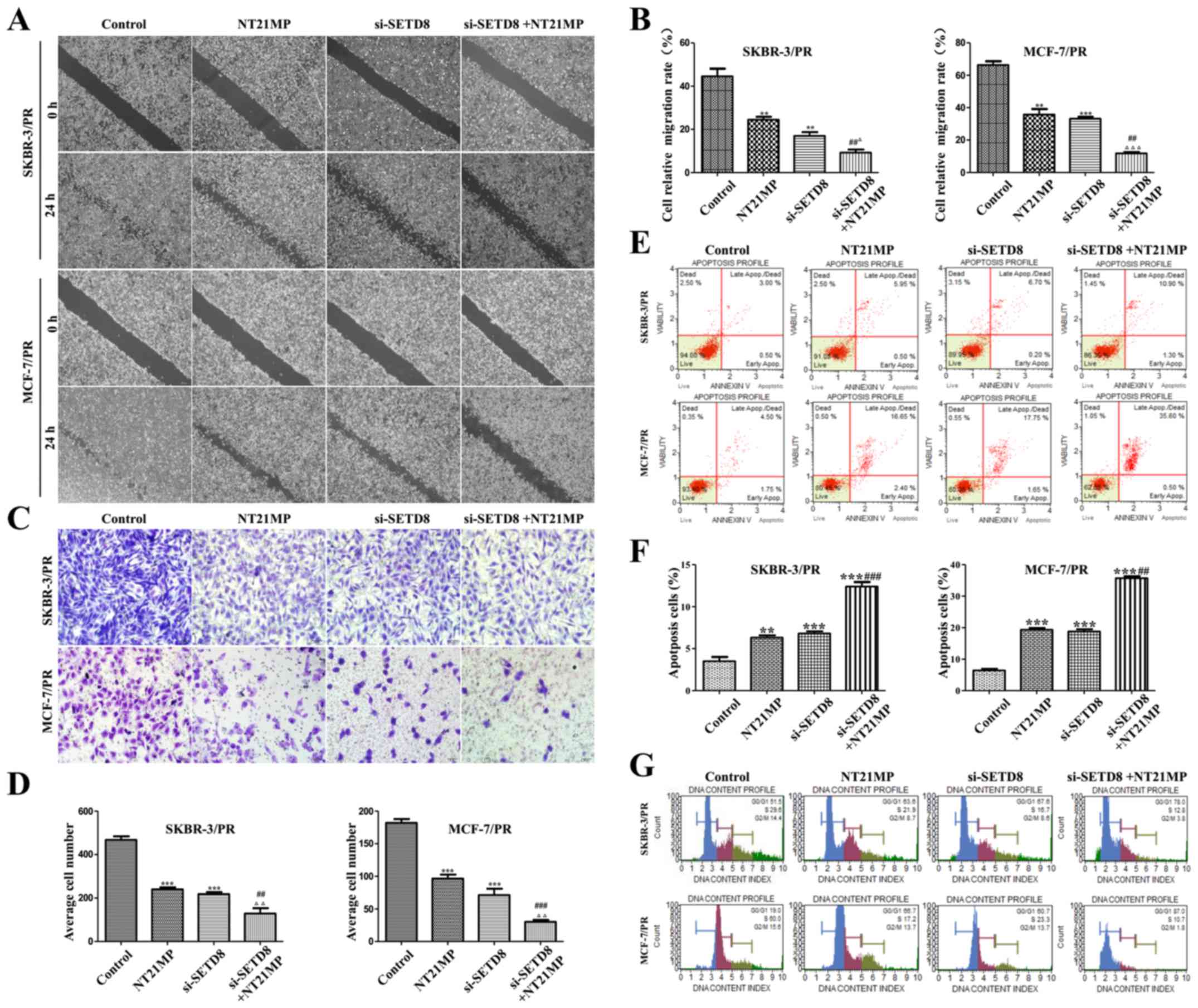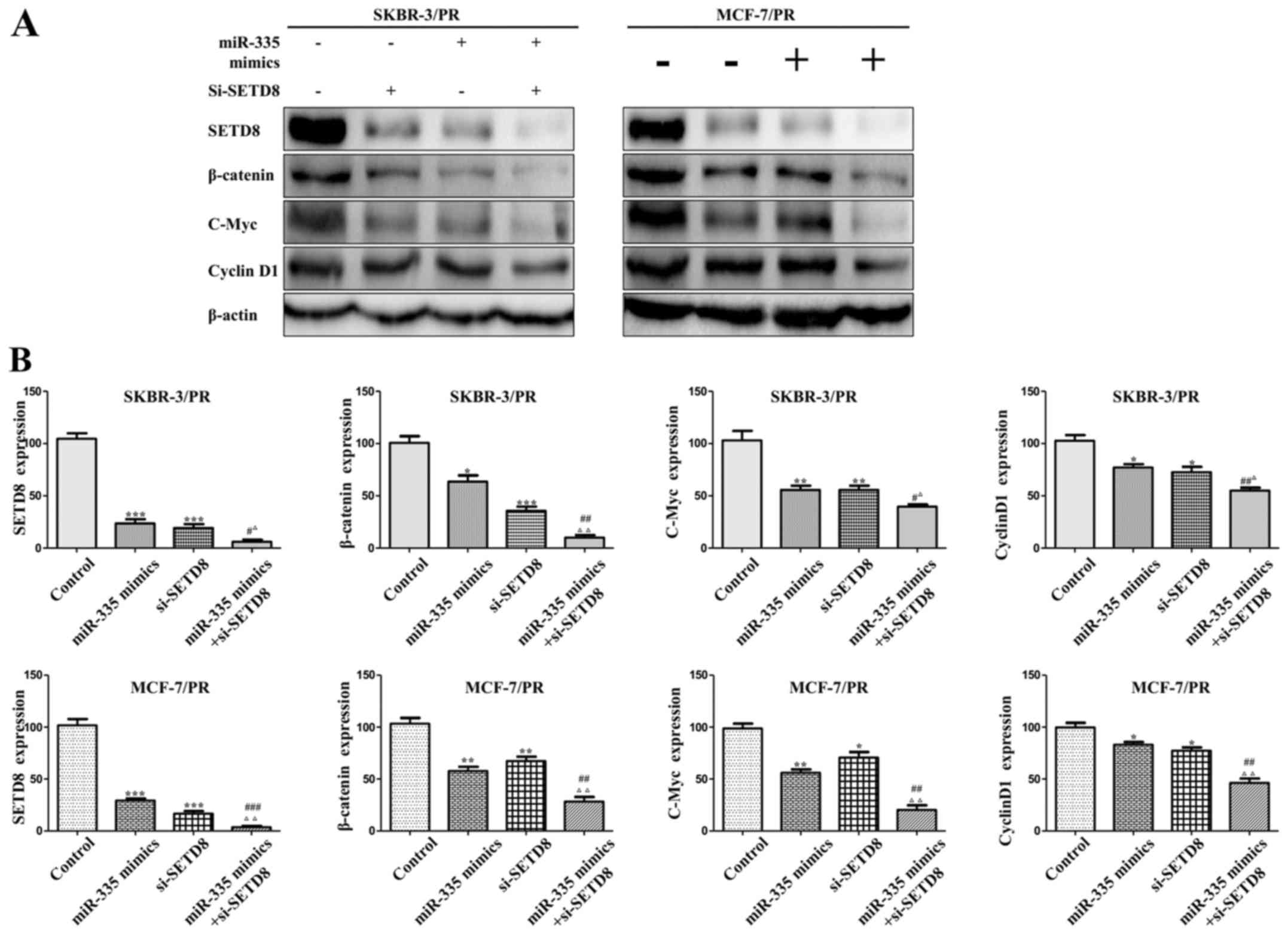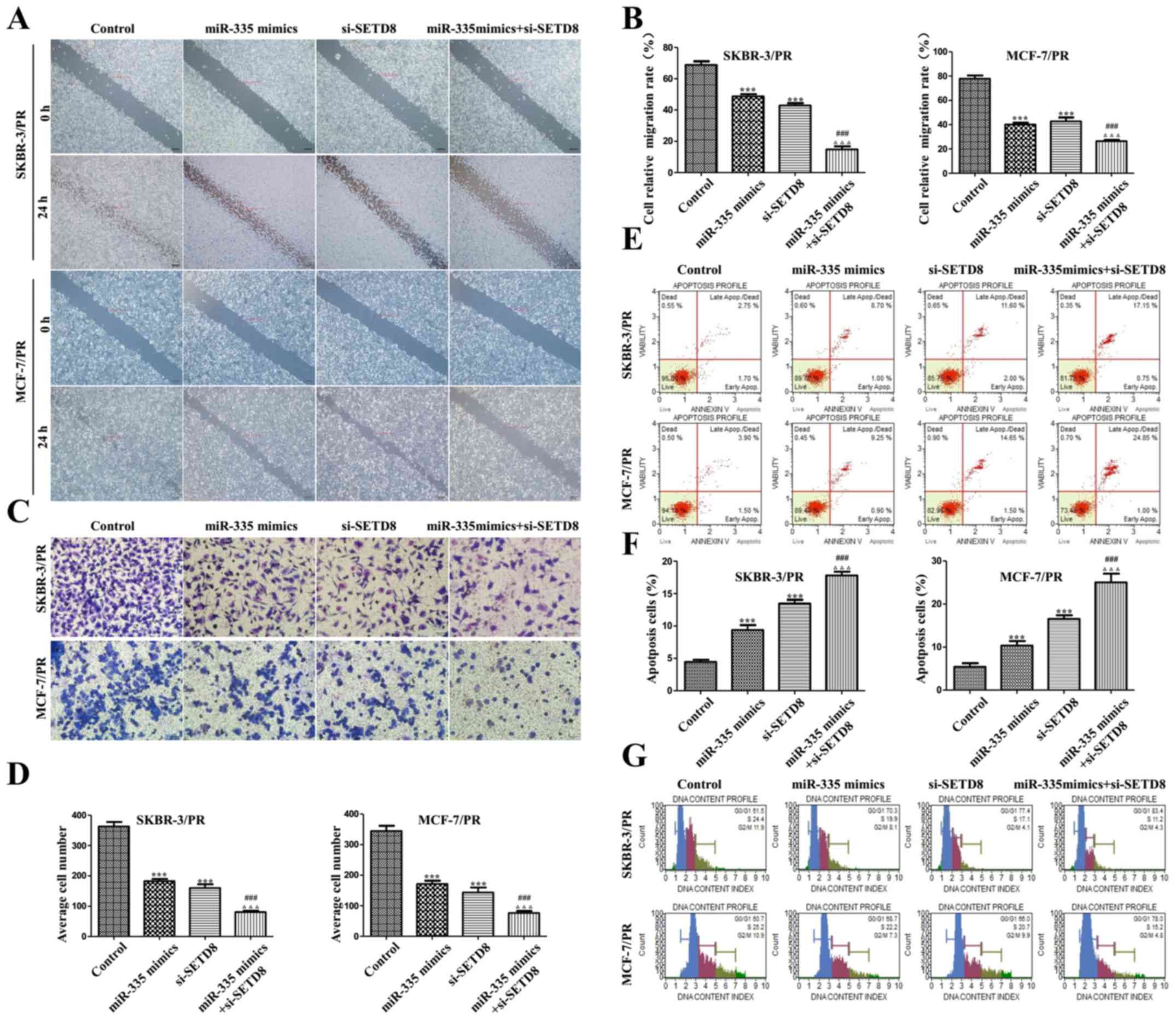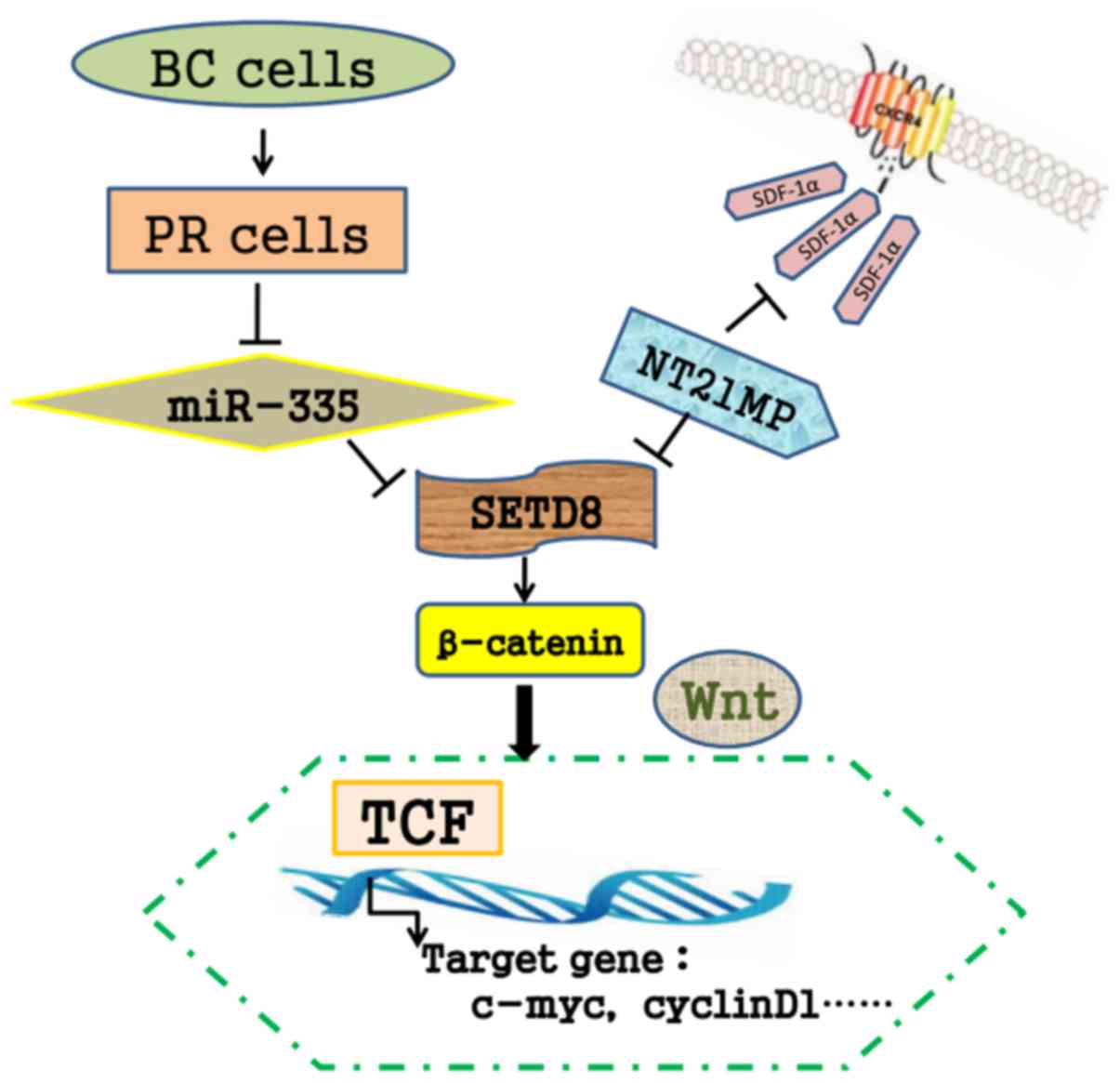N-peptide of vMIP-Ⅱ reverses paclitaxel-resistance by regulating miRNA-335 in breast cancer
- Authors:
- Published online on: July 19, 2017 https://doi.org/10.3892/ijo.2017.4076
- Pages: 918-930
Abstract
Introduction
Breast cancer is one of the most common female cancers in the world. The American Cancer Society provides an overview of female breast cancer statistics in the United States, ~252,710 new cases of invasive breast cancer and 40,610 breast cancer deaths are expected to occur among US women in 2017 (1). Breast cancer is also the highest incidence of female malignant tumor in China, accounting for ~30% (2). The treatments for breast cancer include surgical resection, radiotherapy, endocrinotherapy and chemotherapy. Chemotherapy is one of the standard therapies which have been shown to inhibit tumor growth and prolong survival in patients (3). Paclitaxel has been recognized as the first-line therapy in breast cancer treatment. However, its efficacy is often limited by the development of drug resistance (4,5). Therefore, identifying the underlying mechanism is responsible for regulating chemotherapy resistance for improving breast cancer treatment.
MicroRNAs (miRNAs) are small non-coding RNAs of ~19–25 nucleotides in length, which functions in post-transcriptional regulation of gene expression by binding to the 3′-untranslated region (3′-UTR) (6). Several studies have demonstrated that miRNA misregulation can increase chemo-resistance in cancer if specific proteins are affected (7–9), which indicated that miRNAs might play important roles in drug resistance. For instance, miR-205 enhanced chemosensitivity of breast cancer cells to TAC (docetaxol, doxorubicin plus cyclophosphamide) chemotheraphy by suppressing both VEGFA and FGFZ, leading to evasion of apoptosis (10). A study showed that miR-221/222 confers tamoxifen resistance in breast cancer by targeting P27kip1, a downstream modulator of PI3K/Akt pathway (11). Raza et al reported that miR-644a/CTBP1/P53 axis could suppress drug resistance by simultaneous inhibition of cell survival and epithelial-mesenchymal transition (EMT) in breast cancer (12). Another study revealed that miR-125a-3p function as a tumor suppressor potentiates docetaxel sensitivity by regulating the BRCA1 signaling (13). Moreover, miR-452 could regulate the expression of insulin-like growth factor-1 receptor (IGF-1R), and mediated the change of adriamycin (ADR) resistance of breast cancer MCF-7 cells (14). Furthermore, miR-3646 is an important regulator responsible to Doc-resistant phenotype of breast cancer cells, and manipulates GSK-3β-dependent activation of β-catenin signaling pathway (15). Over the past few years, numerous miRNAs have been reported to be involved in breast cancer tumorigenesis, such as miR-17-59 (16), miR-25 (17), miR-222 (18), miR-375 (19), miR-200c (20), miR-29a (21), miR-145 (22), miR-489 (23,24). Given the major roles of miRNAs in regulating protein expression in general, it is reasonable to infer that targeting miRNAs could be a promising approach to overcome drug resistance.
A growing body of data indicates that miR-335 plays an essential role in drug resistance (25–27). Kim et al found that miR-335/SIAH2/HDAC3 axis regulates the response to anticancer drugs (25). Another study revealed that the expression of miR-335 was downregulated in all the ovarian cancer resistant cells, suggesting a direct involvement in the development of chemoresistance (26). Interestingly, Tang et al found that miR-335 could regulate WW domain binding protein 5 induces multidrug resistance of small cell lung cancer through the Hippo pathway (27). Although these studies have shown the potential role of miR-335 in chemoresistance in human cancer cells, the function of miR-335 in breast cancer remains poorly understood.
Here, we report that miR-335 was downregulated in paclitaxel-resistant (PR) human breast cancer cells and describe the mechanism of PR mediated by miR-335. Our previous study showed that the 21-residue N-terminal of vMIP-II (NT21MP), is a potent antagonist of SDF-1α and CXCR4 (28), could inhibit breast cancer progression and metastasis in vivo (29). In this study, we provide experimental evidence that the use of NT21MP and overexpression of miR-335 suppressed the cells migration and invasion, increased the PR cell apoptosis and arrested cells into G0/G1 phase. Furthermore, SETD8 was validated as a potential target of miR-335, miR-335/SETD8 promoted PR by regulating Wnt/β-catenin signaling pathway activities. Our data provide new insights that miR-335 is potentially a clinically significant breast cancer biomarker.
Materials and methods
Cell culture
Human breast cancer cell lines SKBR-3, MCF-7, paclitaxel-resistant cells (SKBR-3/PR and MCF-7/PR) were cultured at 37°C in 5% CO2 in Dulbecco's modified Eagle's medium (DMEM; Gibco, Gaithersburg, MD, USA) supplemented with 10% fetal bovine serum (FBS). MCF-7/PR and SKBR-3/PR cells were maintained in culture medium with 10 and 25 µg/ml paclitaxel (30).
Reagents and antibodies
NT21MP was designed by our laboratory and synthesized by GL Biochem Ltd. (Shanghai, China). The amino acid sequence information of the NT21MP is H-D-leu-D-Gly-D-Ala-D-Ser-D-Trp-Dhis-D-Arg-D-Pro-D-Asp-D-Lys-Cys-Cys-Leu-Gly-Tyr-GlnLys-Arg-Pro-Leu-Pro-OH. Annexin V and Dead Cell and Cell Cycle Detection kit were purchased from Beyotime (Shanghai, China). Superscript First-Strand Synthesis system was purchased from Thermo Scientific (Waltham, MA, USA). SYBR GreenER™ qPCR Super Mix was from Life Technologies (Carlsbad, CA, USA). Tumor Invasion assay kit was from BD Biosciences (Bedford, MA, USA). Primary antibodies against SETD8, β-catenin, c-Myc and cyclin D1 and β-actin were from Santa Cruz Biotechnology (Santa Cruz, CA, USA).
miRNA real-time RT-PCR
The miRNA RT-PCR was used to detect the alterations of miR-335 expression in breast cancer cells. Briefly, 10 ng of total RNA was reverse transcribed into cDNA using TaqMan miRNA hsa-miR-335-specifc primers (Applied Biosystems). Then real-time PCR was performed using a TaqMan MicroRNA Reverse Transcription kit (Applied Biosystems). RNA U6 was carried out as endogenous control in each sample. The relative expression was analyzed using the comparative Ct method.
Wound healing assay
The PR cells were seeded in 6-well plate until the cells reached 80–90% confluency. The confluent monolayers were scratched with a 10-µl pipette tip to generate the wound. Then cells were washed twice with PBS and further cultured for 24 h to allow wound healing at 37°C with 5% CO2. The photographic images were taken at 0 and 24 h. At least three independent experiments were performed in each cell line.
Western blot analysis
Cells were harvested and lysed with RIPA buffer. The protein concentrations were measured using Bio-Rad protein assay kit (Bio-Rad Laboratories, CA, USA). The proteins were resolved through 10% SDS-polyacrylamide gel electrophoresis and then electrotransferred to PVDF membranes. These membranes were immunoblotted with indicated antibodies for western blotting as described previously (30). Quantification of protein bands was performed using the ImageJ software.
Transwell invasion assays
The invasive activity of cells was measured using Transwell inserts precoated with Matrigel as described earlier (17). Briefly, cells were added to the 24-well upper chamber of the inserts. Cell culture medium with 10% FBS was added to the lower chamber. After incubation for 20 h at 37°C in 5% CO2. Then cells on the upper side of the Transwell were removed, the invading cells on the underside were fixed with 4% paraformaldehyde, and stained with Giemsa solution. The stained invaded cells were photographed under a microscope in five randomly-selected fields.
Apoptosis assay and cell cycle assay
Cells were collected by trypsinization, flow cytometry analysis was performed using an Annexin V and Dead Cell kit and Cell Cycle Detection kit according to the manufacturer's instructions. All experiments were performed in triplicate.
Luciferase reporter assay
The miR-335 response element (wild-type or mutated) in the 3′-UTR of SETD8 was cloned into pMIR-Report (Ambion) plasmid downstream of luciferase reporter gene with firefly luciferase. Cells seeded into 24-well plates were co-transfected with miR-335 mimics (miR-335 inhibitor) and luciferase reporter constructs containing WT or MT SETD8 3′-UTR. After 48 h of transfection, the luciferase activities were measured according to the manufacturer's protocols (Promega). Each experiment was repeated in triplicate.
qRT-PCR assay for gene expression
Total RNA was isolated with TRIzol (Invitrogen, Carlsbad, CA, USA) according to the manufacturer's protocols. Real-time quantitative PCR was performed using an IQ5 Multicolor Detection system (Bio-Rad). The SYBR green RT-PCR assay was described previously (31). The primers used in PCR reactions are: SETD8 forward, 5′-ACT TAC GGA TTT CTA CCC TGT C-3′; reverse, 5′-CGA TGA GGT CAA TCT TCA TTC C-3′. GAPDH forward, 5′-CAG CCT CAA GAT CAT CAG CA-3′; reverse, 5′-TGT GGT CAT GAG TCC TTC CA-3′. β-catenin forward, 5′-GGC TAC TGT TGG ATT GAT TCG AA-3′; reverse, 5′-GCT GGG TAT CCT GAT GTG CAC-3′. c-Myc forward, 5′-GCG ACT CTG AGG AGG AAC A-3′; reverse, 5′-TGA GGA CCA GTG GGC TGT-3′. Cyclin D1 forward, 5′-CCC TCC GTA TCT TAC TTC AA-3′; reverse, 5′-GAT GGT CTG CTT GTT CTC AT-3′.
Transfection
Cells were seeded in 6-well plates and transfected with SETD8 siRNA, or control siRNA using Lipofectamine 2000 as described before (32). The sequences used for SETD8 siRNA are as follows: SETD8 siRNA1, forward oligo, 5′-CAG GAA GAG AAC UCA GUU ATT-3′; reverse oligo, 5′-UAA CUG AGU UCU CUU CCU GTT-3′. SETD8 siRNA2, forward oligo, 5′-GCA ACA GAA UCG CAA ACU UTT-3′; reverse oligo, 5′-AAG UUU GCG AUU CUG UUG CTT-3′. SETD8 siRNA3, forward oligo, 5′-CCU AGG AAG ACU GAU CAA UTT-3′; reverse oligo, 5′-AUU GAU CAG UCU UCC UAG GTT-3′. The non-targeting control siRNA, forward oligo, 5′-UUC UCC GAA CGU GUC ACG UTT-3′; reverse oligo, 5′-ACG UGA CAC GUU CGG AGA ATT-3′. After the transfection, the cells were used for further analysis as described under the results section.
Statistical analysis
Data were expressed as mean ± SEM from at least three independent experiments. All statistical analyses were done using GraphPad Prism 4.0 (GraphPad software, La Jolla, CA, USA). Student's t-test was used to compare different groups. P<0.05 was considered statistically significant.
Results
Downregulation of miR-335 in PR cells
Multiple miRNAs were upregulated and some miRNAs were downregulated in PR cells by miRNA microarray (data not shown). Our previous study on miRNA microarray analysis revealed that miR-335 was significantly downregulated in PR cells compared with parental cells. Heidary et al confirmed that miR-335 critically served as anti-oncogene in breast cancer (33). qRT-PCR was performed to validate that miR-335 was significantly reduced in PR cells, and miR-335 might play a pivotal role in both SKBR-3/PR and MCF-7/PR cells (Fig. 1A).
NT21MP inhibits SDF-1α-induced decrease of miR-335 expression in PR cells
Our previous studies have shown that SDF-1α could promote breast cancer cellular proliferation, metastasis combined with CXCR4. SKBR-3/PR and MCF-7/PR cell treatment with SDF-1α (0.1 µg/ml) lead to the decrease of miR-335 expression, while NT21MP (1 µg/ml) could inhibit the effect of SDF-1α and upregulation of the expression of miR-335 (Fig. 1B).
NT21MP and overexpression of miR-335 inhibit biological activity in PR cells
To further confirm the effect of NT21MP and overexpression of miR-335 in regulation of cell motility, we performed the migration and invasion assays in SKBR-3/PR and MCF-7/PR cells treated with NT21MP and miR-335 mimics. Our wound healing assay showed that NT21MP or miR-335 mimics inhibited the cell migration respectively, and the combine use of NT21MP and miR-335 mimics made a more obvious suppression (Fig. 2A and B). In line with these findings, our invasion assay results revealed that NT21MP and miR-335 mimics suppressed cell invasion in PR cells (Fig. 2C and D). Additionally, we performed cell apoptosis and cell cycle experiments to observe the function of NT21MP and miR-335. Results showed that both miR-335 mimics and NT21MP increased the number of cell apoptosis (Fig. 2E and F) and arrested cells in G0/G1 phase (Fig. 2G and Tables I and II) in both SKBR-3/PR and MCF-7/PR breast cancer cells compared with the control.
Table ICell cycle was arrested in G0/G1 phase treated with NT21MP and miR-335 mimics in SKBR-3/PR cells. |
Table IICell cycle was arrested in G0/G1 phase treated with NT21MP and miR-335 mimics in MCF-7/PR cells. |
miR-335 specifically suppresses SETD8 expression in PR cells
To explore the molecular mechanism by which miR-335 contributes to breast cancer progression. we measured the putative miR-335 target genes, three computational algorithms including TargetScan, miRanda and PicTar were used in combination to search for potential targets of miR-335. Among these genes, SETD8 was identified as a potential target based on a predicted binding site of miR-335 at its 3′-UTR (Fig. 3A). To ascertain whether miR-335 regulates SETD8, we investigated the effects of miR-335 on SETD8 expression in SKBR-3/PR and MCF-7/PR cells. qRT-PCR demonstrated that miR-335 mimics treatment led to a downregulation of SETD8 in SKBR-3/PR and MCF-7/PR cells, whereas miR-335 inhibitor treatment induced an upregulation in SKBR-3 and MCF-7 cells (Fig. 3B). Western blot analysis results showed that SETD8 expression was suppressed by transfection of the miR-335 mimics in SKBR-3/PR and MCF-7/PR cells and enhanced by transfection of the miR-335 inhibitor in MCF-7 and SKBR-3 cells (Fig. 3C). To confirm that miR-335 directly targets the presumed binding sites in the SETD8 3′-UTR and negatively regulates SETD8 expression, we constructed luciferase reporter plasmid with the wild-type and mutant SETD8 3′-UTR region. Results showed a significant decrease in luciferase activity with SETD8 3′-UTR wild-type, but not SETD8 3′-UTR mutation in SKBR-3/PR and MCF-7/PR cells. Consistently, miR-335 inhibitor treatment remarkably increased luciferase activity with wild-type SETD8 in MCF-7 and SKBR-3 cells (Fig. 3D). Collectively, these results indicated that SETD8 was a target gene of miR-335 and might contribute to PR in breast cancer.
NT21MP and overexpression of miR-335 regulate the downstream genes of Wnt/β-catenin signaling pathway
In order to elucidate the mechanism of NT21MP and miR-335 mimics in regulation of the biological activity of PR cells, SETD8 as a target gene of miR-335 was measured. As miR-335 mimics, SETD8 was downregulated after treatment with NT21MP, and it is obviously decreased in combined use of NT21MP and miR-335 mimics (Fig. 4). We then examined the protein and gene expression level of β-catenin by western blot analysis and real-time PCR, respectively. As expected, we observed a reduction of β-catenin in the treatment of NT21MP and miR-335 mimics (Fig. 4). Consistently the expression of the downstream genes of Wnt/β-catenin signaling c-Myc and cyclin D1 were also decreased in both PR cell lines. These findings provided the evidences that NT21MP and miR-335 could regulate Wnt/β-catenin signaling.
NT21MP and si-SETD8 affected PR cells partially through SETD8 mediated-Wnt/β-catenin signaling
To further confirm the function of SETD8 in PR cells, we performed experiment to confirmed that high expression of SETD8 in SKBR-3/PR and MCF-7/PR cells (Fig. 5A and B), which is consistent with low expression of miR-335 in PR cells. To determine whether SETD8 plays a key role in Wnt/β-catenin signaling pathway, we depleted the SETD8 using its specific siRNAs in SKBR-3/PR and MCF-7/PR cells. We found significant decrease of SETD8 with its siRNAs by western blot analysis (Fig. 5C). Then, we used SETD8 siRNA3 for the following experiments. To further illuminate the function of NT21MP and silence of SETD8 reverse drug resistance through Wnt/β-catenin signaling pathway, we detected the expression of β-catenin. Our qRT-PCR results showed that depletion of SETD8 and NT21MP could decreased the expression of β-catenin, more remarkable reduction was seen with combination of both. As the target genes of Wnt/β-catenin signaling pathway, there is also a corresponding reduction of c-Myc and cyclin D1 (Fig. 6A). Western blot analysis showed similar changes in the protein levels (Fig. 6B). Taken together, these results indicated that NT21MP and SETD8 plays a critical role in regulating PR via suppressing Wnt/β-catenin signaling pathway in breast cancer cells.
NT21MP and depletion of SETD8 inhibit biological activity in PR cells
To explore whether NT21MP and si-SETD8 are involved in PR-mediated the variation of cell biological activity. we investigated whether reduction of expression SETD8 could mimic the growth of miR-335. Our wound healing assay showed that NT21MP and SETD8 siRNA transfection could retarded cell motility in PR cells (Fig. 7A and B). Moreover, in line with this findings, our invasion assay results revealed NT21MP and depletion of SETD8 suppressed the cell invasion in SKBR-3/PR and MCF-7/PR cells (Fig. 7C and D), the proportion of apoptotic cells increased (Fig. 7E and F), cell cycle were arrested in G0/G1 phase (Fig. 7G and Tables III and IV), these affects are more significant after combination use of NT21MP and si-SETD8 than used alone. These results suggested that NT21MP and si-SETD8 to a certain extent, reversed the resistance of PR cells in breast cancer.
Table IIICell cycle was arrested in G0/G1 phase treated with NT21MP and si-SETD8 in SKBR-3/PR cells. |
Synergistic effect of combined miR-335 and SETD8 siRNA
We explored whether combination use of si-SETD8 and overexpression of miR-335 had a synergistic or additive effect. As shown in Fig. 8, western blot analysis was performed to detect the expression of SETD8 and its downstream target genes, combination use of miR-335 mimics and si-SETD8 significantly enhanced the function of individual treatment group in both SKBR-3/PR and MCF-7/PR cells. To further detect the correlations and to determine the functional consequences of this combination, cell migration and invasion analysis were performed after treatment with miR-335 mimics and si-SETD8. Results showed that combination of both enhanced the inhibition compared with individual treatment group in both PR cells (Fig. 9A–D). Furthermore, combination of both treatments also showed a synergistic effect in cell apoptosis and accumulated cell cycle into G0/G1 phase (Fig. 9 and Tables V and VI).
Table VCell cycle was arrested in G0/G1 phase treated with miR-335 mimics and si-SETD8 in SKBR-3/PR cells. |
Table VICell cycle was arrested in G0/G1 phase treated with miR-335 mimics and si-SETD8 in MCF-7/PR cells. |
Discussion
A number of studies have demonstrated that miRNAs are involved in the occurrence and development of breast cancer. Experimental evidence has demonstrated that dysregulation of miR-335 play an important role in breast cancer progression and metastasis (34). For instance, miR-335 inhibits proliferation, cell cycle progression, colony formation and invasion via targeting PAX6 in breast cancer cells (35). A study showed that miR-335 inhibits migration of breast cancer cells through targeting oncoprotein c-met (36). Some studies have demonstrated that miR-335 is a suppressor of breast cancer metastasis, loss of miR-335 leads to the activation of SOX4 and TNC (encoding tenascin C), which are responsible for the acquisition of metastatic properties (37,38), additionally, miR-335 is directly associated with relapse. Interestingly, Png et al identified miR-335 as a robust inhibitor of breast cancer reinitiation (39), and miR-335 acts as a metastasis suppressor, as a decrease in its expression could be connected to the ability to form breast cancer metastasis in mice (40). In this study, we compared the expression of two paclitaxel sensitive and resistant cell line pairs and identified miR-335 as a miRNA that can modulate the sensitivity to paclitaxel in breast cancer cells.
Nowadays, studies increasingly focus on the regulation function of individual miRNAs on cancer cells, but only for a very small fraction, their targets are experimentally affirmed. In our study, we explored the molecular mechanism underlying the function of miR-335 and found that SETD8 is one of the target gene. SETD8 (also known as SET8, PR-SET7 or KMT5A), first characterized in 2002, is the only known PKMT (protein lysine methyltransferase) that catalyzes the monomethylation of histone H4 lysine 20 (H4K20) (41–43). Several studies have demonstrated that SETD8 is involved in cell cycle regulation, invasion cell maturation and survival (44,45), SETD8 also plays an important role in the progress of human cancer. For instance, Zhang et al found that miR-127-3p inhibits proliferation and invasion by targeting SETD8 in human osteosarcoma cells (46). Moreover, high expression of SETD8 was associated with a shorter survival time in gastric cancer patients, and SETD8 was found to be an independent predictor of gastric cancer outcome (47). Additionally, modulation of SETD8 is associated with breast cancer (48–50). In line with these observations, our data showed that SETD8 was also necessary for the migration and invasion activity and PR of breast cancer cells, co-treatment with miR-335 mimics and si-SETD8 significantly enhanced the effect compared with individual treatment group, which is mediated by Wnt/β-catenin signaling.
Recent studies revealed that Wnt signaling plays a critical role in a wide range of biological and pathophysiological processes (51,52). Accumulating evidence has suggested that SETD8 was critically involved in Wnt/β-catenin signaling. Knockdown of SETD8 reduces H4K20mel, and consequently, several of the tested Wnt target genes show reduced activation (53) and it was plausible to test whether SETD8 is recruited through interaction with β-catenin. Li et al reported that SETD8 is a Wnt signaling mediator and is recruited by LEF1/TCF4 to regulate the transcription of Wnt-activated genes (54). Additionally, reduced PPARγ-setd8-H4K20mel would be associated with reduced Wnt signaling genes β-catenin, and Wnt target gene Axin2 (55). In line with the role of miRNAs in regulating Wnt/β-catenin, we found that upregulation miR-335 could decrease β-catenin expression in PR cells. In particular, knockdown of SETD8 by siRNA displays a phenomenon with the effect of miR-335 in PR cells.
As β-catenin is a critical component of the well-studied Wnt/β-catenin signaling pathway, when Wnt/β-catenin signaling is activated, β-catenin degradation is inhibited. Cyclin D1 is a cycle related gene which can promote the cell cycle from G1-S phase transition period at the downstream of Wnt/β-catenin signaling pathway (56). Boonmuen et al also demonstrated that Wnt/β-catenin signaling target genes include c-Myc, cyclin D1 and Axin2 in MCF-7 and MDA-MB-231 cells (57). Thus, our findings suggested that SETD8 as a target gene of miR-335, may represent a promising therapeutic target of PR breast cancer cells through Wnt signaling and its downstream genes c-Myc and cyclin D1. However, the mechanism by which SETD8 regulates Wnt/β-catenin signaling activity remains to be investigated.
We previously synthesized NT21MP and demonstrated that NT21MP could inhibit cellular proliferation, promote apoptosis and inhibit the progression of breast cancer in vivo (29). As shown in Fig. 10, our results showed that SDF-1α acting at CXCR4 induced the downregulation of miR-335, NT21MP as a potent antagonist could attenuates these changes. The combined use of NT21MP and overexpression of miR-335 or silence of SETD8 contributes to the reduction of PR breast cancer cell migration and invasion, influencing the proportion of apoptotic cells and the cell cycle.
To this end, our data suggested that NT21MP is a potent antagonist, and miR-335 level might serve as a potential biomarker of PR breast cancer and that miR-335 overexpression might aid in overcoming breast cancer cell drug resistance. Our findings revealed that miR-335 might function as an important miRNAs in paclitaxel resistance by regulating SETD8 and could serve as a promising candidate for therapeutic intervention.
In conclusion, we have identified that miR-335 can regulate breast cancer paclitaxel-resistance through its direct target gene SETD8 and Wnt/β-catenin signaling pathway. Both miR-335 and SETD8 may be used to predict the prognosis of patients with drug resistance of breast cancer. NT21MP, as a small molecules compound may represent new therapeutic strategy of breast cancer. However, more investigation needs to be carried out to illustrate how SETD8 regulates Wnt signaling, the potential therapeutic role of miRNAs and NT21MP remains a major clinical challenge.
Acknowledgments
This study was supported by funding from the Major Program of Anhui Educational Committee (nos. KJ2015ZD29 and KJ2016SD37), the Natural Science Foundation of Anhui (no. 1508085MH159), the Key Program of college discipline (major) top-notch talent academic subsidy of Anhui (no. gxbjZD2016069), the grant from a Key Program of Anhui Educational Committee (KJ2016A474), the Program for science research of Bengbu Medical College (no. BYKY14147ZD), the Program for graduates research of Bengbu Medical College (no. Byycx1615) and the Bengbu municipal scientific research Key projects (no. 20150309).
References
|
Rebecca L, Siegel MPH, Kimberly D and Miller MPH: Issue Information. CA Cancer J Clin. 67:1–85. 2017. View Article : Google Scholar | |
|
Parkin DM, Bray F, Ferlay J and Pisani P: Global cancer statistics, 2002. CA Cancer J Clin. 55:74–108. 2005. View Article : Google Scholar : PubMed/NCBI | |
|
Zardavas D, Baselga J and Piccart M: Emerging targeted agents in metastatic breast cancer. Nat Rev Clin Oncol. 10:191–210. 2013. View Article : Google Scholar : PubMed/NCBI | |
|
Tang X, Jin L, Cao P, Cao K, Huang C, Luo Y, Ma J, Shen S, Tan M, Li X, et al: MicroRNA-16 sensitizes breast cancer cells to paclitaxel through suppression of IKBKB expression. Oncotarget. 7:23668–23683. 2016. View Article : Google Scholar : PubMed/NCBI | |
|
Armat M, Oghabi Bakhshaiesh T, Sabzichi M, Shanehbandi D, Sharifi S, Molavi O, Mohammadian J, Saeid Hejazi M and Samadi N: The role of Six1 signaling in paclitaxel-dependent apoptosis in MCF-7 cell line. Bosn J Basic Med Sci. 16:28–34. 2016.PubMed/NCBI | |
|
Mirnezami AH, Pickard K, Zhang L, Primrose JN and Packhamå G: MicroRNAs: Key players in carcinogenesis and novel therapeutic targets. Eur J Surg Oncol. 35:339–347. 2009. View Article : Google Scholar | |
|
Bartel DP: MicroRNAs: Genomics, biogenesis, mechanism, and function. Cell. 116:281–297. 2004. View Article : Google Scholar : PubMed/NCBI | |
|
Lewis BP, Burge CB and Bartel DP: Conserved seed pairing, often flanked by adenosines, indicates that thousands of human genes are microRNA targets. Cell. 120:15–20. 2005. View Article : Google Scholar : PubMed/NCBI | |
|
Verghese ET, Hanby AM, Speirs V and Hughes TA: Small is beautiful: microRNAs and breast cancer-where are we now? J Pathol. 215:214–221. 2008. View Article : Google Scholar : PubMed/NCBI | |
|
Hu Y, Qiu Y, Yagüe E, Ji W, Liu J and Zhang J: miRNA-205 targets VEGFA and FGF2 and regulates resistance to chemotherapeutics in breast cancer. Cell Death Dis. 7:e22912016. View Article : Google Scholar : PubMed/NCBI | |
|
Zhu J, Zhou Q and Tan S: Targeting miRNAs associated with surface expression of death receptors to modulate TRAIL resistance in breast cancer. Cancer Lett. 383:154–160. 2016. View Article : Google Scholar : PubMed/NCBI | |
|
Raza U, Saatci Ö, Uhlmann S, Ansari SA, Eyüpoğlu E, Yurdusev E, Mutlu M, Ersan PG, Altundağ MK, Zhang JD, et al: The miR-644a/CTBP1/p53 axis suppresses drug resistance by simultaneous inhibition of cell survival and epithelial-mesenchymal transition in breast cancer. Oncotarget. 7:49859–49877. 2016. View Article : Google Scholar : PubMed/NCBI | |
|
Xu X, Lv YG, Yan CY, Yi J and Ling R: Enforced expression of hsa-miR-125a-3p in breast cancer cells potentiates docetaxel sensitivity via modulation of BRCA1 signaling. Biochem Biophys Res Commun. 479:893–900. 2016. View Article : Google Scholar : PubMed/NCBI | |
|
Hu Q, Gong JP, Li J, Zhong SL, Chen WX, Zhang JY, Ma TF, Ji H, Lv MM, Zhao JH, et al: Down-regulation of miRNA-452 is associated with adriamycin-resistance in breast cancer cells. Asian Pac J Cancer Prev. 15:5137–5142. 2014. View Article : Google Scholar : PubMed/NCBI | |
|
Zhang X, Zhong S, Xu Y, Yu D, Ma T, Chen L, Zhao Y, Chen X, Yang S, Wu Y, et al: MicroRNA-3646 contributes to docetaxel resistance in human breast cancer cells by GSK-3β/β-catenin signaling pathway. PLoS One. 11:e01531942016. View Article : Google Scholar | |
|
Fang L, Li H, Wang L, Hu J, Jin T, Wang J and Yang BB: MicroRNA-17–5p promotes chemotherapeutic drug resistance and tumour metastasis of colorectal cancer by repressing PTEN expression. Oncotarget. 5:2974–2987. 2014. View Article : Google Scholar : PubMed/NCBI | |
|
Wang Z, Wang N, Liu P, Chen Q, Situ H, Xie T, Zhang J, Peng C, Lin Y and Chen J: MicroRNA-25 regulates chemoresistance-associated autophagy in breast cancer cells, a process modulated by the natural autophagy inducer isoliquiritigenin. Oncotarget. 5:7013–7026. 2014. View Article : Google Scholar : PubMed/NCBI | |
|
Shen H, Wang D, Li L, Yang S, Chen X, Zhou S, Zhong S, Zhao J and Tang J: MiR-222 promotes drug-resistance of breast cancer cells to adriamycin via modulation of PTEN/Akt/FOXO1 pathway. Gene. 596:110–118. 2017. View Article : Google Scholar | |
|
Ward A, Balwierz A, Zhang JD, Küblbeck M, Pawitan Y, Hielscher T, Wiemann S and Sahin Ö: Re-expression of microRNA-375 reverses both tamoxifen resistance and accompanying EMT-like properties in breast cancer. Oncogene. 32:1173–1182. 2013. View Article : Google Scholar | |
|
Chen Y, Sun Y, Chen L, Xu X, Zhang X, Wang B, Min L and Liu W: miRNA-200c increases the sensitivity of breast cancer cells to doxorubicin through the suppression of E-cadherin-mediated PTEN/Akt signaling. Mol Med Rep. 7:1579–1584. 2013.PubMed/NCBI | |
|
Shen H, Li L, Yang S, Wang D, Zhong S, Zhao J and Tang J: MicroRNA-29a contributes to drug-resistance of breast cancer cells to adriamycin through PTEN/AKT/GSK3β signaling pathway. Gene. 593:84–90. 2016. View Article : Google Scholar : PubMed/NCBI | |
|
Gao M, Miao L, Liu M, Li C, Yu C, Yan H, Yin Y, Wang Y, Qi X and Ren J: miR-145 sensitizes breast cancer to doxorubicin by targeting multidrug resistance-associated protein-1. Oncotarget. 7:59714–59726. 2016. View Article : Google Scholar : PubMed/NCBI | |
|
Jiang L, He D, Yang D, Chen Z, Pan Q, Mao A, Cai Y, Li X, Xing H, Shi M, et al: MiR-489 regulates chemoresistance in breast cancer via epithelial mesenchymal transition pathway. FEBS Lett. 588:2009–2015. 2014. View Article : Google Scholar : PubMed/NCBI | |
|
Chen X, Wang YW, Xing AY, Xiang S, Shi DB, Liu L, Li YX and Gao P: Suppression of SPIN1-mediated PI3K-Akt pathway by miR-489 increases chemosensitivity in breast cancer. J Pathol. 239:459–472. 2016. View Article : Google Scholar : PubMed/NCBI | |
|
Kim Y, Kim H, Park D and Jeoung D: miR-335 targets SIAH2 and confers sensitivity to anti-cancer drugs by increasing the expression of HDAC3. Mol Cells. 38:562–572. 2015. View Article : Google Scholar : PubMed/NCBI | |
|
Sorrentino A, Liu CG, Addario A, Peschle C, Scambia G and Ferlini C: Role of microRNAs in drug-resistant ovarian cancer cells. Gynecol Oncol. 111:478–486. 2008. View Article : Google Scholar : PubMed/NCBI | |
|
Tang R, Lei Y, Hu B, Yang J, Fang S, Wang Q, Li M and Guo L: WW domain binding protein 5 induces multidrug resistance of small cell lung cancer under the regulation of miR-335 through the Hippo pathway. Br J Cancer. 115:243–251. 2016. View Article : Google Scholar : PubMed/NCBI | |
|
Yang QL, Li CH, Ding YX, Chen CJ, Zhang J and Wang H: Inhibitory effect of polypeptide to inhibit CXCR4 on metastasis of breast cancer cell line. CTM. 20:89–92. 2008. | |
|
Yang QL, Ding YX, Chen CJ, Tang J, Zhang J and Yang ZF: Suppression of murine breast cancer metastasis by selective inhibition of CXCR4 by synthetic polypeptide derived from viral macrophage inflammatory protein II. Chin Sci Bull. 55:2152–2159. 2010. View Article : Google Scholar | |
|
Yang Q, Huang J, Wu Q, Cai Y, Zhu L, Lu X, Chen S, Chen C and Wang Z: Acquisition of epithelial-mesenchymal transition is associated with Skp2 expression in paclitaxel-resistant breast cancer cells. Br J Cancer. 110:1958–1967. 2014. View Article : Google Scholar : PubMed/NCBI | |
|
Chen S, Zhu L, Huang J, Cai Y, Lu X, Yang Q, Wu Q, Chen C and Wang Z: Arsenic trioxide targets miR-125b in glioma cells. Curr Pharm Des. 20:5354–5361. 2014. View Article : Google Scholar : PubMed/NCBI | |
|
Wu Q, Wang R, Yang Q, Hou X, Chen S, Hou Y, Chen C, Yang Y, Miele L, Sarkar FH, et al: Chemoresistance to gemcitabine in hepatoma cells induces epithelial-mesenchymal transition and involves activation of PDGF-D pathway. Oncotarget. 4:1999–2009. 2013. View Article : Google Scholar : PubMed/NCBI | |
|
Heidary MF, Mahmoodzadeh Hosseini H, Mehdizadeh Aghdam E, Nourani MR, Ranjbar R, Mirnejad R and Imani Fooladi AA: Overexpression of metastatic related microRNAs, mir-335 and mir-10b, by Staphylococcal enterotoxin B in the metastatic breast cancer cell line. Adv Pharm Bull. 5:255–259. 2015. View Article : Google Scholar : PubMed/NCBI | |
|
Yang R, Dick M, Marme F, Schneeweiss A, Langheinz A, Hemminki K, Sutter C, Bugert P, Wappenschmidt B, Varon R, et al: Genetic variants within miR-126 and miR-335 are not associated with breast cancer risk. Breast Cancer Res Treat. 127:549–554. 2011. View Article : Google Scholar | |
|
Meng Y, Zou Q, Liu T, Cai X, Huang Y and Pan J: microRNA-335 inhibits proliferation, cell-cycle progression, colony formation, and invasion via targeting PAX6 in breast cancer cells. Mol Med Rep. 11:379–385. 2015. | |
|
Gao Y, Zeng F, Wu JY, Li HY, Fan JJ, Mai L, Zhang J, Ma DM, Li Y and Song FZ: MiR-335 inhibits migration of breast cancer cells through targeting oncoprotein c-Met. Tumour Biol. 36:2875–2883. 2015. View Article : Google Scholar | |
|
Negrini M and Calin GA: Breast cancer metastasis: A microRNA story. Breast Cancer Res. 10:2032008. View Article : Google Scholar : PubMed/NCBI | |
|
Tavazoie SF, Alarcón C, Oskarsson T, Padua D, Wang Q, Bos PD, Gerald WL and Massagué J: Endogenous human microRNAs that suppress breast cancer metastasis. Nature. 451:147–152. 2008. View Article : Google Scholar : PubMed/NCBI | |
|
Png KJ, Yoshida M, Zhang XH, Shu W, Lee H, Rimner A, Chan TA, Comen E, Andrade VP, Kim SW, et al: MicroRNA-335 inhibits tumor reinitiation and is silenced through genetic and epigenetic mechanisms in human breast cancer. Genes Dev. 25:226–231. 2011. View Article : Google Scholar : PubMed/NCBI | |
|
Erturk E, Cecener G, Egeli U, Tunca B, Tezcan G, Gokgoz S, Tolunay S and Tasdelen I: Expression status of let-7a and miR-335 among breast tumors in patients with and without germ-line BRCA mutations. Mol Cell Biochem. 395:77–88. 2014. View Article : Google Scholar : PubMed/NCBI | |
|
Nishioka K, Rice JC, Sarma K, Erdjument-Bromage H, Werner J, Wang Y, Chuikov S, Valenzuela P, Tempst P, Steward R, et al: PR-Set7 is a nucleosome-specific methyltransferase that modifies lysine 20 of histone H4 and is associated with silent chromatin. Mol Cell. 9:1201–1213. 2002. View Article : Google Scholar : PubMed/NCBI | |
|
Fang J, Feng Q, Ketel CS, Wang H, Cao R, Xia L, Erdjument-Bromage H, Tempst P, Simon JA and Zhang Y: Purification and functional characterization of SET8, a nucleosomal histone H4-lysine 20-specific methyltransferase. Curr Biol. 12:1086–1099. 2002. View Article : Google Scholar : PubMed/NCBI | |
|
Beck DB, Oda H, Shen SS and Reinberg D: PR-Set7 and H4K20me1: At the crossroads of genome integrity, cell cycle, chromosome condensation, and transcription. Genes Dev. 26:325–337. 2012. View Article : Google Scholar : PubMed/NCBI | |
|
DeVilbiss AW, Sanalkumar R, Hall BD, Katsumura KR, de Andrade IF and Bresnick EH: Epigenetic determinants of erythropoiesis: Role of the histone methyltransferase SetD8 in promoting erythroid cell maturation and survival. Mol Cell Biol. 35:2073–2087. 2015. View Article : Google Scholar : PubMed/NCBI | |
|
Malik J, Getman M and Steiner LA: Histone methyltransferase Setd8 represses Gata2 expression and regulates erythroid maturation. Mol Cell Biol. 35:2059–2072. 2015. View Article : Google Scholar : PubMed/NCBI | |
|
Zhang J, Hou W, Chai M, Zhao H, Jia J, Sun X, Zhao B and Wang R: MicroRNA-127-3p inhibits proliferation and invasion by targeting SETD8 in human osteosarcoma cells. Biochem Biophys Res Commun. 469:1006–1011. 2016. View Article : Google Scholar | |
|
Shi XL, Guo ZJ, Wang XL, Liu XL and Shi GF: SET8 expression is associated with overall survival in gastric cancer. Genet Mol Res. 14:15609–15615. 2015. View Article : Google Scholar : PubMed/NCBI | |
|
Song F, Zheng H, Liu B, Wei S, Dai H, Zhang L, Calin GA, Hao X, Wei Q, Zhang W, et al: An miR-502-binding site single-nucleotide polymorphism in the 3′-untranslated region of the SET8 gene is associated with early age of breast cancer onset. Clin Cancer Res. 15:6292–6300. 2009. View Article : Google Scholar : PubMed/NCBI | |
|
Yu N, Huangyang P, Yang X, Han X, Yan R, Jia H, Shang Y and Sun L: microRNA-7 suppresses the invasive potential of breast cancer cells and sensitizes cells to DNA damages by targeting histone methyltransferase SET8. J Biol Chem. 288:19633–19642. 2013. View Article : Google Scholar : PubMed/NCBI | |
|
Yang F, Sun L, Li Q, Han X, Lei L, Zhang H and Shang Y: SET8 promotes epithelial-mesenchymal transition and confers TWIST dual transcriptional activities. EMBO J. 31:110–123. 2012. View Article : Google Scholar | |
|
Logan CY and Nusse R: The Wnt signaling pathway in development and disease. Annu Rev Cell Dev Biol. 20:781–810. 2004. View Article : Google Scholar : PubMed/NCBI | |
|
Clevers H: Wnt/beta-catenin signaling in development and disease. Cell. 127:469–480. 2006. View Article : Google Scholar : PubMed/NCBI | |
|
Schotta G: H4K20 monomethylation faces the WNT. Proc Natl Acad Sci USA. 108:3097–3098. 2011. View Article : Google Scholar : PubMed/NCBI | |
|
Li Z, Nie F, Wang S and Li L: Histone H4 Lys 20 monomethylation by histone methylase SET8 mediates Wnt target gene activation. Proc Natl Acad Sci USA. 108:3116–3123. 2011. View Article : Google Scholar : PubMed/NCBI | |
|
Ke X, Xing B, Yu B, Yu X, Majnik A, Cohen S, Lane R and Joss-Moore L: IUGR disrupts the PPARγ-Setd8-H4K20me(1) and Wnt signaling pathways in the juvenile rat hippocampus. Int J Dev Neurosci. 38:59–67. 2014. View Article : Google Scholar : PubMed/NCBI | |
|
Tamamori-Adachi M, Ito H, Sumrejkanchanakij P, Adachi S, Hiroe M, Shimizu M, Kawauchi J, Sunamori M, Marumo F, Kitajima S, et al: Critical role of cyclin D1 nuclear import in cardiomyocyte proliferation. Circ Res. 92:e12–e19. 2003. View Article : Google Scholar : PubMed/NCBI | |
|
Boonmuen N, Thongon N, Chairoungdua A, Suksen K, Pompimon W, Tuchinda P, Reutrakul V and Piyachaturawat P: 5-Acetyl goniothalamin suppresses proliferation of breast cancer cells via Wnt/β-catenin signaling. Eur J Pharmacol. 791:455–464. 2016. View Article : Google Scholar : PubMed/NCBI |



